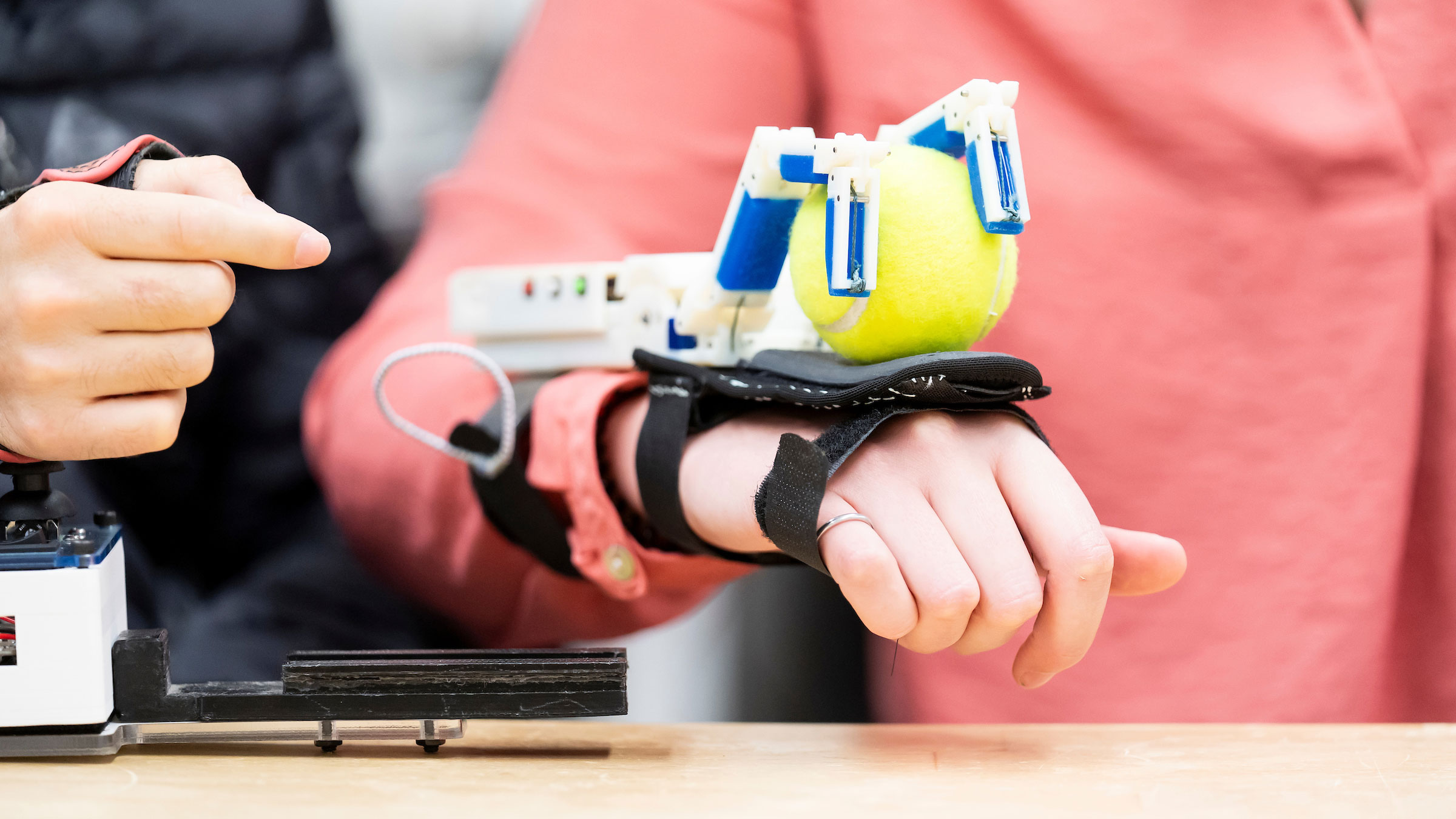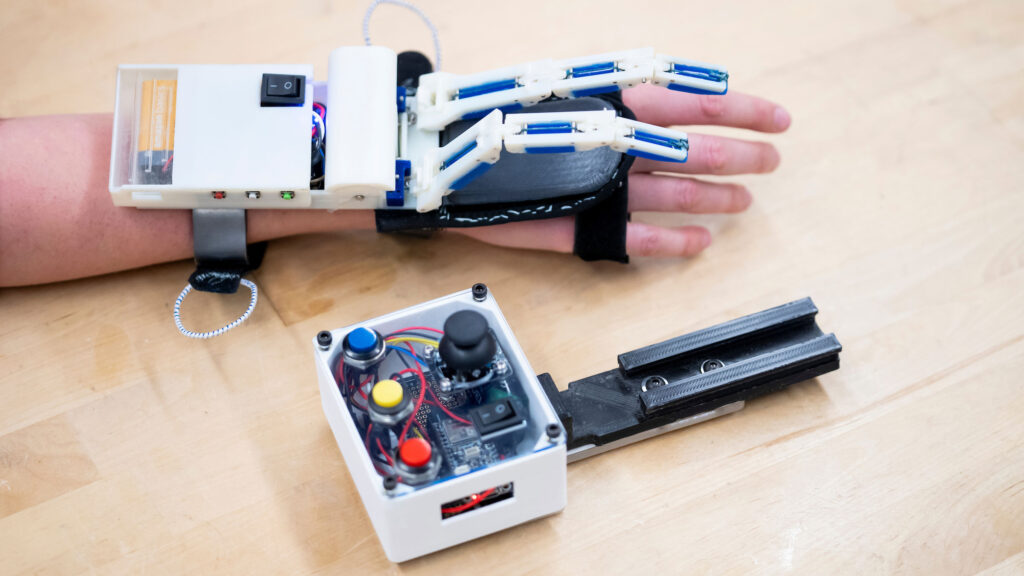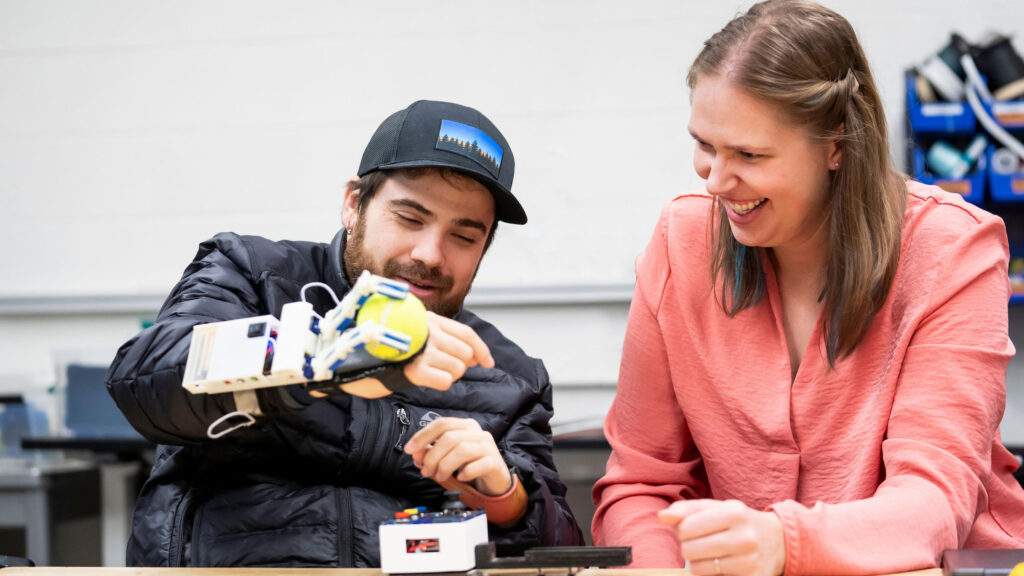New Device Enhances Grasping for People With Spinal Cord Injuries
Dorsal Grasper provides an intuitive, collaborative grasping approach

More than 15 million people worldwide are living with spinal cord injury (SCI), which can affect their sensory and motor functions below the injury level. For individuals with SCI between C5 and C7 cervical levels, this can mean paralysis affecting their limbs and limited voluntary finger and wrist flexion, making it difficult to grasp large, heavy objects.
Now, a team of UC Berkeley engineers from the Embodied Dexterity Group has developed a wearable device to enhance grasping functionality in this population. Dubbed the Dorsal Grasper, this assistive device leverages voluntary wrist extension and uses supernumerary robotic fingers on the back of the hand to facilitate human-robot collaborative grasping.
In a study recently featured in IEEE Transactions on Neural Systems and Rehabilitation Engineering, the researchers demonstrated for the first time how the Dorsal Grasper can expand users’ graspable workspace. Test subjects found that they could easily grasp objects anywhere they could reach their arm, without having to rotate their bodies, which can cause wheelchair users to lose their balance.
Associate professor Hannah Stuart, Ph.D. student Andrew “Drew” McPherson and postdoctoral researcher Jungpyo Lee — all with the Department of Mechanical Engineering — spoke with UC Berkeley Engineering about their research and the challenges of designing a device that people will want to use.
What’s unique about the Dorsal Grasper?
Hannah: We’ve designed the Dorsal Grasper to enable what we call collaborative grasping. People with tetraplegia will often retain the ability to extend the wrist backward but don’t have the ability to flex it forward, so they have this directionality. And people can be strong in their wrist, in extension, and that’s an important part of daily function. We wanted to enhance that capability by enabling grasping, but in such a way that the person is an active partner in the grasp.

Another unique feature is the device’s use of robotic fingers to grasp with the back of the hand. Today, robotic wearables often fit around the person’s fingers, which creates a tension between what the person and the robot each want to do. With supernumerary grasping, both the person and robot are free to act as they see fit. And while grasping with the back of the hand may look a little silly, we believe it has great advantages that could one day allow the Dorsal Grasper to be an accessible and effective device.
Drew: This population also generally uses wheelchairs to get around. So it can be hard to approach certain surfaces head-on, like counters or the refrigerator, to grab something, given that the legs are in the way. And with limited trunk control and overall body mobility, that kind of graspable workspace, or being able to reach things off a counter, is really restricted.
This device stands out in that you can grasp with one hand pretty much anywhere you can reach that arm, which greatly expands your workspace. And you can grasp larger objects by using the supernumerary robotic fingers.
What did you learn from your latest in-lab tests of the Dorsal Grasper?
Jungpyo: Based on our in-lab testing with the Dorsal Grasper, we found that subjects could reach their hand out and rotate their hand a lot. So they could simply rotate their head to see the location and then easily grasp the object. This was possible because the robotic finger could be controlled with just wrist extension, something they use all the time. In follow-up interviews, many subjects mentioned that this control method made operating the device feel really intuitive.
Hannah: And we achieved such intuitive operation without relying on any fancy components, like EMG [electromyography] sensors or neural interfaces.
Jungpyo: The person is a partner, controlling the robotic finger and wrist extension. For example, sometimes the force of the robotic finger is not enough to grasp a heavy object. In that case, a person can extend their wrist more and increase grasping force, so they can successfully achieve this grasping. And if we want to drop an object of any size, we can simply release our wrist and grasping force and drop the object immediately, without waiting for a robotic response. Compared to a fully robotic system, the Dorsal Grasper allows for a faster response.
How does the Dorsal Grasper help advance the field of assistive technology?
Drew: A lot of devices seek to replace or do the same type of grasping that people are doing already, and the Dorsal Grasper isn’t trying to do that at all. I haven’t seen a lot of devices that adequately support intent detection, which is a significant challenge within the field. With Dorsal Grasper, we’re able to use people’s residual strength and their ability to move their wrist. That partial body power allows the device to read their intention to grab things, which allows for fewer false positives, or fewer accidental grasps. And this then makes it a little bit easier to use the device.
And it’s not about just the device, but how we’re assessing the device. We’re not simply creating tasks that highlight the benefits of the robot, but rather we’re looking at ways that this device might be able to help someone in real life. Often this process involves applying my own lived experience as a person with SCI.
Drew, you’re about to wrap up your Ph.D. and have been working on this project for many years. What’s changed since you first started this research?
Drew: What’s changed the most is how I think about usability and design. I’ve become more critical of how devices can be used and how they can also get in the way. I think a lot of these devices are looked at in a very narrow scope of, “here’s a couple sets of tasks that we’re going to demonstrate in a lab.” But that doesn’t necessarily translate.
That said, I truly did not have an appreciation for how difficult of a design challenge this would be: To build something that a user would not only want to wear because it’s comfortable, but also looks okay and isn’t going to stand out in the grocery store or look weird unless they want it to look futuristic — and some users do. Again, it’s going to need to be easy enough to take on and off. Otherwise, it’s going to just get discarded and stuffed in a closet and never get used.
What have you learned from working with subjects while testing the Dorsal Grasper?
Hannah: We’ve realized that even though someone has tetraplegia, they might still retain a lot of dexterity and ability. And we’ve grown an appreciation for the abilities that a person has in the absence of the device that we’re introducing. Our testing allows us to then see if the introduction of the device might negatively impact them or add new abilities.

So we specifically included evaluation of people wearing the device but not using it. This comes back to that idea that Drew was talking about: Do you have to take it on and off? Is it practical? Is it useful? The first thing a device needs to do is not get in the way. By placing the fingers on the back of the hand, it’s our hope that that it stays out of the way, so that whatever somebody could do with their hands before, whether it’s throughout the whole front surface or side surface, that remains unimpeded.
Drew: And it’s important to look at how people adapt. How they might come up with different grasps. If we develop a device that might get in the way of how they do things already, they might be getting a net negative rather than a net positive in terms of being able to do something. And that will have a real impact on whether they use the device. If you can do the task without the device, and now it’s even harder, or if you can do the equal amount, there’s no reason to put the effort in to use the device.
What’s next for the Dorsal Grasper?
Drew: Our latest version, which we’ve been working on for a little over a year, is designed specifically for the home. This version of the Dorsal Grasper is untethered, which means that the motors, batteries and everything else are physically on the wrist, built into the device.
We’re also building it out to be more robust because, in the home, people can grab and wrench on things differently than in a controlled lab environment. We can’t predict what they’ll do or how they might break it. So testing it and breaking it, fixing it and redesigning it has been the process.
For more information
